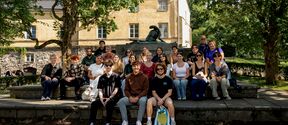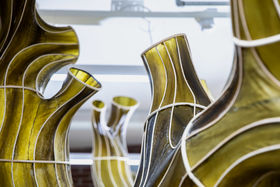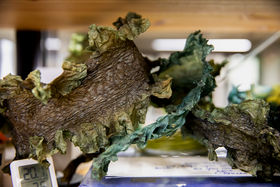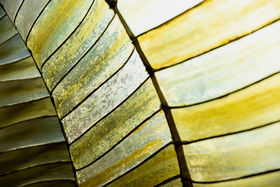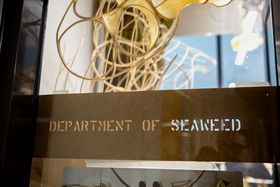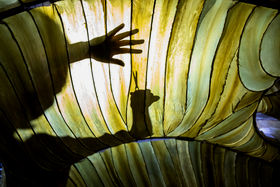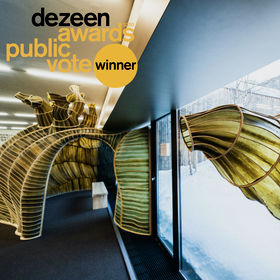Julia Lohmann: ‘We know too much and do too little’
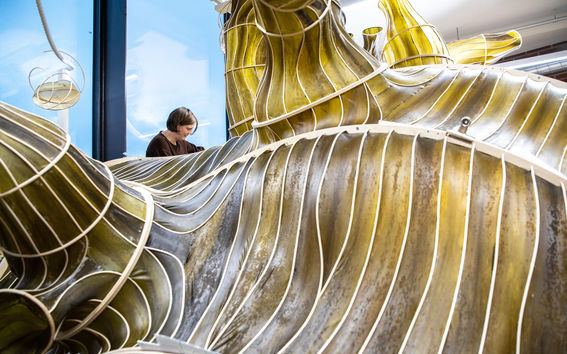
Lohmann’s magnificent seaweed pavilion encourages leaders to make difficult decisions and establish a ‘do-tank’ way of collaborating at the 50th World Economic Forum in Davos.
World leaders gather each January at the World Economic Forum’s (WEF) Annual Meeting in Davos, Switzerland. The meeting brings together over 3,000 leaders of business, international politics and culture, as well as economists, celebrities and journalists for an intense few days of discussion about global issues. This year, Julia Lohmann, internationally acknowledged designer and professor of practice in contemporary design at Aalto University, is one of the 40 cultural leaders invited.
In the hallway connecting the WEF’s main plenary sessions, Lohmann will be building a multisensorial seaweed pavilion, entitled Hidaka Ohmu. The pavilion represents 'The ‘Department of Seaweed’, a community of practice Lohmann founded around the sustainable development of seaweed as a material for making. Hidaka Ohmu will have open workshops and enable delegates to work with seaweed themselves. With her fascinating and thought-provoking seaweed sculptures and interventions, Lohmann joins the ranks of Greta Thunberg, Sylvia Earle and Al Gore to call for urgent changes to address the climate crisis.
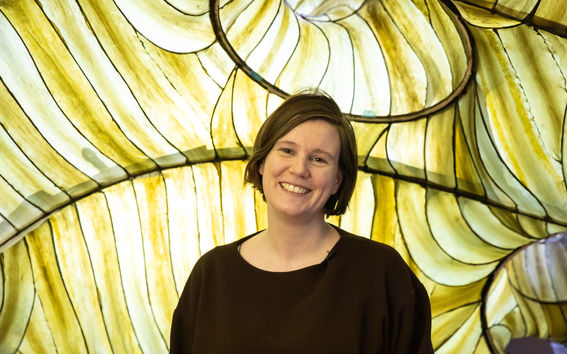
When you approach Lohmann’s pavilion, you can’t ignore the strong scent of the sea, Lohmann’s installation enables visitors to immerse themselves with all their senses. Through it, she is encouraging everyone to try and get closer to the sea and its lifeforms.
Hidaka Ohmu’s message is relevant to Davos participants because it highlights our limits as humans. No human can ever know the ocean like the species that live underwater but at the same time, our way of life constantly impacts the ocean. ‘We must become aware of these limits of our knowledge and empathically engage with the species we impact. We need to put their needs at the centre of every decision we make since they have as equal a right to life on this planet as we do’ Lohmann adds.
Lohmann refers to Peter Senge, a world-famous scholar who has studied organisational change and empathy. She says his theories of system change suggest that ‘it’s not enough to intellectually understand the challenges we’re facing, we also have to understand emotionally what the decisions we need to make are, and how we can be brave enough to make the decisions and change.’
Julia LohmannIt’s always scary to change.
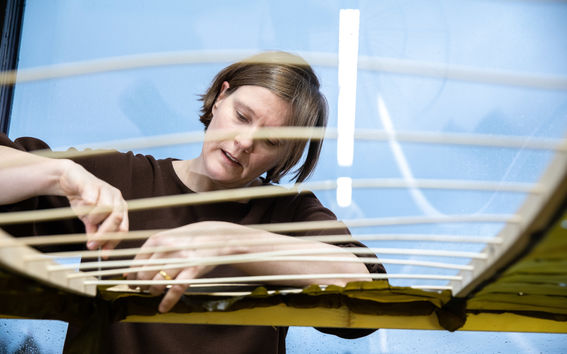
In Davos, Lohmann’s Department of Seaweed is part of an exhibition called Partnering with Nature, which is curated by Cooper Hewitt, the Smithsonian Design Museum. The exhibition consists of four projects in which designers are collaborating with nature.
Lohmann calls for new ways of working: alternative ways of doing instead of endless meetings and e-mails, in which we talk and write about what we should be doing. ‘The World Economic Forum visitors can make seaweed badges with us and get the feeling of what it has taken to make Hidaka Ohmu. Through this involvement in actually designing and making, we’ll get another form of dialogue with the world leaders’.
Lohmann explains, ‘Talking while you make something is compelling – people are emotionally invested and curious. In this sense, making is very similar to actually being in nature, in which we are sometimes required to stay silent and work together. It also requires us to stop thinking and act instinctively, and sometimes vice versa. It’s kind of our natural mode of being and it’s a lovely space to be.’
The Department of Seaweed’s message to the world leaders
Lohmann says we tend to think and do things for the short term,‘In terms of the ecological crisis, we are on the cliff edge already. We really need to start doing things differently now, and really focus on the long-term impact’.
Lohmann says that her message in Davos is three-fold.
- ‘First, be conscious of every decision you make:Learn to ask for permission from your great-grandchildren. Is what I’m doing really necessary? Should I invest in this de-futuring company? What long-term impact does it have? Is it necessary to fly or buy something? Always, always think a couple of generations ahead.’
- ‘Secondly, do things differently: We have many think tanks but now we need to establish “do tanks”. We know what we need to do, so we can’t afford to spend our time writing new recommendations. We have to act now’. Lohmann suggests embedding design into the process of decision-making because design is the discipline of doing,‘Within our institutions, we shouldn’t deprive our visitors of the engaging experience of making something together by showing them just the finished outcomes.’
- ‘Thirdly, start taking remedial actions. We have to be more agile and build links between science and society. My work promotes seaweed that can be farmed sustainably; it’s the bamboo of the oceans. Seaweed is more than just a material: It is a means of regenerating degraded marine ecosystems. We can also use it as fertiliser and turn it into bioplastic, biofuel, dyes, veneer and textiles. While it grows, it cleans the ocean of harmful excess nutrients such as agricultural run-offs and fish farm faeces. Lots of people are researching it, but it still needs more work across many different disciplines. At Aalto, I have seed funding with the School of Chemical Engineering to establish new research on this topic’.
When building bridges between different institutions and groups, Lohmann’s first step is trying to find a common language together. This means translating – or discarding – terminology, and finding analogies between work in one field and another. Plans are often slow to implement simply because different stakeholders speak in different languages.
‘For example, many outcomes of science are not really understood by a large part of society, because it’s a very intellectual way of engaging. Additionally, policymakers might not know how designers, engaged in social change, work across disciplines. Design can play a role in realising changes on a vast scale by making abstract things relatable. Designers are helping people make sense of science, to empower them to tackle the complex challenges we are facing – humanity's greatest endeavour ever’ Lohmann says.

How to put design into action in decision-making?
Lohmann thinks that it’s critical how we teach what design is. ‘There are so many young designers out there, who ask what is left for them to design. It’s a bit of a paradox, we’ve taught them how to make objects, and now, most of the problems we have can’t be solved by making objects, they have to be solved by doing something else’.
‘Design needs to be redefined from ‘we make objects’ to ‘we enable change for sustainability’. That is a significant change in itself. You have to teach people how to build frameworks in which design can play this role. There are quite a few designers who want to work in this way, but there are not enough openings for them to survive financially.
In an ideal world, what would Lohmann then suggest to the World Economic Forum? ‘They could invite designers to sit in each plenary session, and use that as a briefing: here’s the network of people who want to make that change. As a designer, you could help in visualising what changes are necessary and involve participants in enacting some of the changes that have been proposed. So, whenever there’s a briefing for policymakers, that briefing could also work for designers, provided they were given a budget to do this.’
Lohmann sees that the Finnish public sector has been a pathfinder in this. ‘In Finland, there are these amazing piloting budgets from which you can get a mini-grant if you have a good idea. So why not get designers into these processes to suggest ideas that can then be implemented with mini-grants?’. Some of the projects that our Department of Design does, like Design for Government and the collaboration with the city of Helsinki, are steps in this direction, towards having designers on board to think about where design could help in implementing change.
‘The ecosystem has reached a tipping point. It is up to us to act – and we must act now.’
Text: Tiina Toivola
Photos: Mikko Raskinen
Partnering with Nature – Design is a force for change
Through this powerful, interactive exhibition, Cooper Hewitt will invite leaders to rethink our relationship to nature and jumpstart the dialogue on sustainability practices on an international scale.
Four installations will encourage participants to play with natural elements, learn about the symbiotic relationships in nature and be inspired to imagine a more cohesive approach to working with nature.
Read more about Cooper Hewitt's Partnering with Nature exhibition
Stakeholder capitalism at World Economic Forum
On the Forum’s 50th Anniversary, World Economic Forum has issued a new manifesto to replace shareholder capitalism with ‘stakeholder capitalism’, an ideology that would better meet the systemic changes related to the fourth industrial revolution, climate crisis, automation and globalisation.
Klaus Schwab, founder of World Economic Forum, describes that ‘the young Swedish climate activist, Greta Thunberg has reminded us that adherence to the current economic system represents a betrayal of future generations, owing to its environmental unsustainability.
Read more news

Seizing opportunities
Vuong Vo's path led through Aalto University and VTT to a startup, where he is helping build the protein factory of the future.Growing Materials, Growing Ideas: Inside the BioMaker Studio
At Aalto University’s BioMaker Studio, initiated by Ena Naito, students and researchers experiment with living materials, from algae to mycelium, creating an open, interdisciplinary space where design, biology, and collaboration grow together.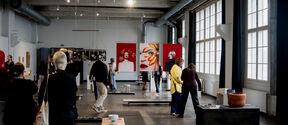
The year in Review: What happened in 2025?
A recap of the milestones of the Master in Contemporary Design in 2025